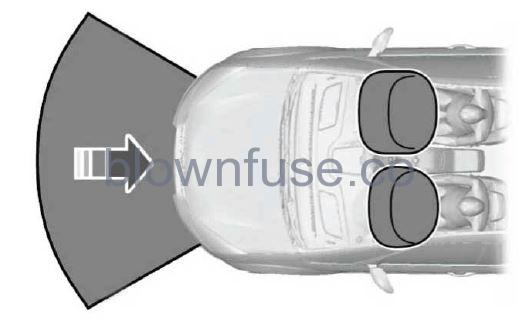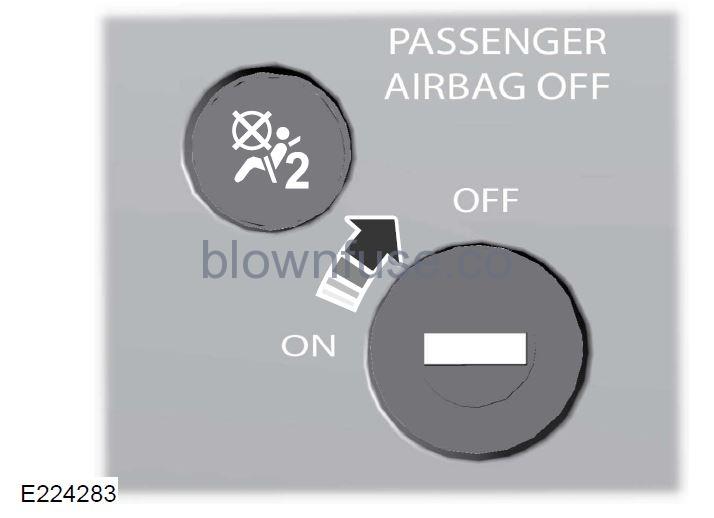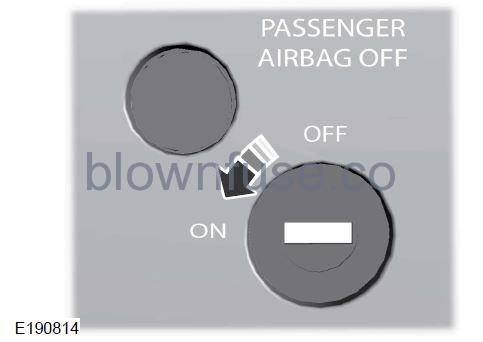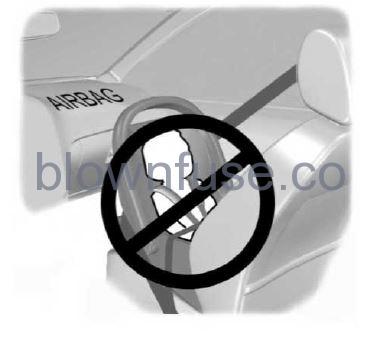`
2023 Ford E-350 Driver and Passenger Airbags
 DRIVER AND PASSENGER AIRBAGS
DRIVER AND PASSENGER AIRBAGS
- WARNING: Do not place your arms on the airbag cover or through the steering wheel. Failure to follow this instruction could result in personal injury.
- WARNING: Do not place a rearward-facing child restraint in front of an active airbag. Failure to follow this instruction could result in personal injury or death.

The driver and front passenger airbags deploy during significant frontal and near frontal crashes. The driver and passenger front airbag system consist of:
- Driver and passenger airbag modules
 Crash sensors and monitoring system with readiness indicator. See Crash Sensors and Airbag Indicator (page 40).
Crash sensors and monitoring system with readiness indicator. See Crash Sensors and Airbag Indicator (page 40).
Passenger Airbag On and Off Switch (If Equipped)
WARNING: Your vehicle may have an airbag deactivation switch. Before driving, always look at the switch to make sure it is in the appropriate position. Failure to put the switch in the proper position can increase the risk of serious injury or death in a crash.
Note: The passenger airbag on and off switch may be on vehicles with no rear seats.
Switching the Passenger Airbag Off
- WARNING: If the light does not illuminate when the passenger airbag switch is off and you switch the ignition on, have the passenger airbag switch serviced immediately by a qualified technician.
- WARNING: To avoid switching on the airbag, always remove the ignition key with the switch in the off position.
- WARNING: NEVER use a rearward-facing child restraint on a seat protected by an ACTIVE AIRBAG in front of it, DEATH or SERIOUS INJURY to the CHILD can occur.

- Insert the ignition key into the passenger airbag on and off switch, turn the switch to off, and hold it in off while removing the key.
- When you switch the ignition on and the passenger airbag switch is in the off position, the off light illuminates briefly, momentarily shuts off, and then turns back on. This indicates that the passenger airbag is deactivated.
Switching the Passenger Airbag Back On
- WARNING: The seatbelts for the driver and right-front passenger seating positions are specifically designed to operate together with the airbags in certain types of crashes. When you switch off your airbag, you not only lose the protection of the airbag, but you also may reduce the effectiveness of your seatbelt system. If the passenger does not meet the requirements stated in the National Highway Traffic Safety Administration or Transport Canada deactivation criteria, switching off the airbag can increase the risk of serious injury or death in a crash.
- WARNING: If your vehicle has rear seats, always transport children who are 12 and younger in the rear seat. Always use seatbelts and child restraints properly. Do not place a child in a rear-facing infant seat in the front seat unless your vehicle is equipped with an airbag on and off switch and the passenger airbag is turned off. This is because the back of the infant seat is too close to the inflating airbag and the risk of a fatal injury to the infant when the airbag inflates is substantial.
- WARNING: If the passenger airbag off light is illuminated when the passenger airbag switch is on and the ignition is on, have the passenger airbag switch serviced immediately by a qualified technician.
The passenger airbag remains off until you switch it back on.
- Insert the ignition key into the passenger airbag on and off switch and turn the switch to on.
- The off light briefly illuminates when you switch the ignition on. This indicates that the passenger airbag is operational.
The passenger-side airbag should always be on (the airbag off light should not be illuminated) unless the passenger is a person who meets the requirements stated either in Category 1, 2 or 3 of the National Highway Traffic Safety
Administration/Transport Canada deactivation criteria which follow.
The vast majority of drivers and passengers are much safer with an airbag than without. To do their job and reduce the risk of life-threatening injuries, airbags must open with great force, and this force can pose a potentially deadly risk in some situations, particularly when a front seat occupant is not properly buckled up. The most effective way to reduce the risk of unnecessary airbag injuries without reducing the overall safety of the vehicle is to make sure all occupants are properly restrained in the vehicle, especially in the front seat. This provides the protection of seatbelts and permits the airbags to provide the additional protection they were designed to provide. If you choose to deactivate your airbag, you are losing a very significant risk-reducing the benefits of the airbag and you are also reducing the effectiveness of the seatbelts because seatbelts in modern vehicles are designed to work as a safety system with the airbags.
National Highway Traffic Safety Administration Deactivation Criteria (Excluding Canada)
WARNING: This vehicle has special energy management seatbelts for the driver and right-front passengers. These particular seatbelts are specifically designed to work with airbags to help reduce the risk of injury in a crash. The energy management seatbelt gives or releases additional seatbelt webbing in some accidents to reduce the concentration of force on an occupant’s chest and to reduce the risk of certain bone fractures and injuries to underlying organs. In a crash, if the airbag is off, this energy management seatbelt might permit the passenger wearing the seatbelt to move forward enough to have a serious or fatal injury. The more severe the crash, and the heavier the occupant, the greater the risk. Make sure the airbag is on for any passenger who does not qualify under the National Highway Traffic Safety Administration deactivation criteria.
- Infant. An infant (less than 1-year-old) must ride in the front seat because:
- The vehicle has no rear seat.
- The vehicle has a rear seat too small to accommodate a rear-facing infant seat.
- The infant has a medical condition which, according to the infant’s physician, makes it necessary for the infant to ride in the front so that the driver can constantly monitor the child’s condition.
- Children age: 1 to 12. A child aged 1 to 12 must ride in the front seat because:
- The vehicle has no rear seat.
- Although children ages 1 to 12 ride in the rear seat(s) whenever possible, children ages 1 to 12 sometimes must ride in the front because no space is available in the rear seat(s) of the vehicle.
- The child has a medical condition which, according to the child’s physician, makes it necessary for the child to ride in the front seat so that the driver can constantly monitor the child’s condition.
- Medical condition: A passenger has a medical condition which, according to his or her physician:
- Causes the passenger airbag to pose a special risk for the passenger.
- Makes the potential harm from the passenger airbag in a crash greater than the potential harm from turning off the airbag and allowing the passenger, even if belted, to hit the dashboard or windshield in a crash.
Transport Canada Deactivation Criteria (Canada Only)
WARNING: This vehicle has special energy management seatbelts for the driver and right-front passenger. These particular seatbelts are specifically designed to work with airbags to help reduce the risk of injury in a crash. The energy management seatbelt gives or releases additional seatbelt webbing in some accidents to reduce the concentration of force on an occupant’s chest and to reduce the risk of certain bone fractures and injuries to underlying organs. In a crash, if the airbag is off, this energy management seatbelt might permit the passenger wearing the seatbelt to move forward enough to have a serious or fatal injury. The more severe the crash, and the heavier the occupant, the greater the risk. Make sure the airbag is on for any passenger who does not qualify under the Transport Canada deactivation criteria.
- Infant: An infant (less than 1-year-old) must ride in the front seat because:
- My vehicle has no rear seat.
- The rear seat in my vehicle cannot accommodate a rear-facing infant seat.
- The infant has a medical condition that, according to the infant’s physician, makes it necessary for the infant to ride in the front seat so that the driver can monitor the infant’s condition.
- Child age 12 or under: A child age 12 or under must ride in the front seat because:
- My vehicle has no rear seat.
- Although children age 12 and under ride in the rear seat whenever possible, children age 12 and under have no option but to sometimes ride in the front seat because rear-seat space is insufficient.
- The child has a medical condition that, according to the child’s physician, makes it necessary for the child to ride in the front seat so that the driver can monitor the child’s condition.
- Medical condition: A passenger has a medical condition that, according to his or her physician:
- Poses a special risk for the passenger if the airbag deploys.
- Makes the potential harm from the passenger airbag deployment greater than the potential harm from turning off the airbag and experiencing a crash without the protection offered by the airbag.
Proper Driver and Front Passenger Seating Adjustment
WARNING: National Highway Traffic Safety Administration (NHTSA) recommends a minimum distance of at least 10 in (25 cm) between an occupant’s chest and the driver’s airbag module.
To properly position yourself away from the airbag:
- Move your seat to the rear as far as you can while still reaching the pedals comfortably.
- Recline the seat slightly (one or two degrees) from the upright position.
After all occupants have adjusted their seats and put on seatbelts, it is very important that they continue to sit properly. Properly seated occupants sit upright, lean against the seatback, and center themselves on the seat cushion, with their feet comfortably extended on the floor. Sitting improperly can increase the chance of injury in a crash event. For example, if an occupant slouches, lies down, turns sideways, sits forward, leans forward or sideways, or puts one or both feet up, the chance of injury during a crash is greatly increased.
Children and Airbags
WARNING: Do not place a rearward-facing child restraint in front of an active airbag. Failure to follow this instruction could result in personal injury or death.

Children must always be properly restrained. Accident statistics suggest that children are safer when properly restrained in the rear seating position than in the front seating position. Failure to follow these instructions may increase the risk of injury in a crash.

